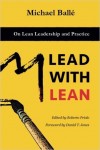Lead With Lean: A new perspective
Why are new ideas so hard to have? Because we use our minds to think, and it’s incredibly hard to spot our own thinking biases as you think. I’ve learned the hard way, that this is something you can’t do yourself, or by yourself. To explore new thoughts you must collaborate with others and experiment firsthand. In many ways, gemba remains the greatest teacher.

https://www.amazon.fr/dp/1540480844/
Lead With Lean is a collection of essays that go all the way back to 1993 – (23 years ago? Gracious!), most of them written with either other leading lean thinkers (and mentors) or executives (and co-explorers), in a wide variety of fields. This voyage of discovery enabled us to give shape to the strongest biases in our thinking about business – we’ve had to seriously change our minds about:
- Human performance is a dynamic process, not the optimization of a static one: I came to realize that I saw “organization” as the perfect way to assemble the right boxes and then staff trained people into each of these boxes to “fine tun” and optimise the system through operational excellence tools. I now know that the dynamic nature of Just-in-time and the challenging nature of lean and kaizen is precisely what creates long-term performance by giving people a sense of direction and progress, even when adverse events make it tough to find easy wins.
- Leadership can be learned and taught, and no one is either a “born leaders” or a “born followers” – this made me radically rethink my assumptions that there are leaders and followers to seeing that in dynamic situations there are leaders and leaders, but on different points and different levels. This brought me to see what David Marquet calls “leader-leader” relationships and developing everyday leadership skills in everyone; Everyone can learn to lead in their immediate environment.
- A lean system is a learning system, not just a management system. We progressively realized that, ultimately, the roots of all business success was to understand how technical understanding can be put to use to help customers with their problems. As customer issues change rapidly and technical problems are every trickier, the key is to see lean (the generalization of TPS) as a learning system to explore new ways of doing things at value-adding level, as opposed to a management system to keep things running as they are.
Our search is the search for a business system that reconciles customer satisfaction and employee satisfaction, profits and people development, the company and its social environment. This is not a myth – we’ve seen it happen time and time again, but it certainly takes a different kind of thinking which hingers on deepening the relationship between employees and their work through their own responsibility for their knowledge, and deepening the relationship between work and customer benefits through better understanding what is going on. In two words, greater ingenuity, deeper wisdom.
Lead With Lean is more fieldbook than lecture. It doesn’t make a theoretical argument, but looks at various aspects of lean and leadership with the aim of making the reader think. It’s not the end of an argument but the beginning of a conversation. I hope you enjoy reading it as much as it was fun writing it through the years, learning from extraordinary teachers and working with fantastic partners.
Check it out on amazon: Lead With Lean









